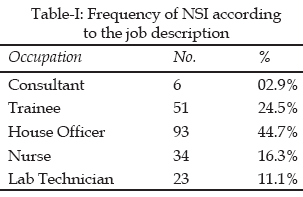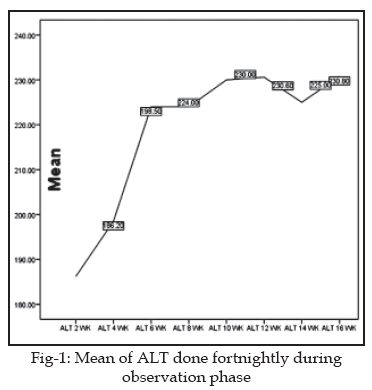After four weeks of therapy seven (77.8%) patients achieved
rapid virological response (RVR) and were given 16 weeks therapy. The two
(22.2%) patients who did not achieve RVR were tested for early virological
response at 12th
week both showed > two log reduction in viral load and were continued for
total 24 weeks therapy. Both tested negative for HCV RNA at the end of 24
weeks thus achieving the end treatment response (ETR). Testing for sustained
virological response (SVR) 24 weeks off treatment in all the patients showed
that only one patient developed relapse, this patient belonged to the group of
patient who did not achieve RVR. The SVR rate in our series was eight (88.9%)
in acute HCV after NSI.
1. Wicker S, Cinatl J, Berger A, Doerr HW, Gottschalk R,
Rabenau HF. Determination of Risk of Infection with Blood-borne Pathogens
Following a Needlestick Injury in Hospital Workers. Ann Occup Hyg
2008;52:615-622.
2. Wicker S, Jung J, Allwinn R, Gottschalk R, Rabenau HF.
Prevalence and prevention of needlestick injuries among health care workers in
a German university hospital. Int Arch Occup Environ Health 2008;81:347-54.
3. Moro PL, Moore A, Balcacer P, Montero A, Diaz D, Gomez
V, et al. Epidemiology of needlesticks and other sharps injuries and injection
safety practices in the Dominican Republic. Am J Infect Control 2007;35:552-9.
4. Haber PS, Young MM, Dorrington L, Jones A, Kaldor J, De
Kanzow S, et al. Transmission of hepatitis C virus by needle-stick injury in
community settings. J Gastroenterol Hepatol 2007;22:1882-5.
5. Chung RT. Acute hepatitis C virus infection. Clin Infect
Dis 2005;41 Suppl 1:S14-7.
6. Thomas DL, Seeff LB. Natural history of hepatitis C.
Clin Liver Dis 2005;9:383-98, vi.
7. Fabris P, Fleming VM, Giordani MT, Barnes E. Acute
hepatitis C: clinical aspects, diagnosis, & outcome of acute HCV infection.
Curr Pharm Des 2008;14:1661-5.
8. Guobuzaite A, Chokshi S, Balciuniene L, Voinic A,
Stikleryte A, Zagminas K, et al. Viral clearance or persistence after acute
hepatitis C infection: interim results from a prospective study. Medicina (Kaunas)
2008;44:510-20.
9. Jaeckel E, Cornberg M, Wedemeyer H, Santantonio T, Mayer
J, Zankel M, et al. Treatment of acute hepatitis C with interferon alfa-2b. N
Engl J Med 2001;345:1452-7.
10. Pruss-Ustun A, Rapiti E, Hutin Y. Estimation of the
global burden of disease attributable to contaminated sharps injuries among
health-care workers. Am J Ind Med 2005;48:482-90.
11. Morrison AL, Beckmann U, Durie M, Carless R, Gillies
DM. The effects of nursing staff inexperience (NSI) on the occurrence of
adverse patient experiences in ICUs. Aust Crit Care 2001;14:116-21.
12. Orland JR, Wright TL, Cooper S. Acute hepatitis C.
Hepatology 2001;33:321-7.
13. Ogata K, Ide T, Kumashiro R, Kumada H, Yotsuyanagi H,
Okita K, et al. Timing of interferon therapy and sources of infection in
patients with acute hepatitis C. Hepatol Res 2006;34:35-40.
14. Caruntu FA, Benea L. Acute hepatitis C virus infection:
Diagnosis, pathogenesis, treatment. J Gastrointestin Liver Dis 2006;15:249-56.
15. Kamal SM. Acute hepatitis C: a systematic review. Am J
Gastroenterol 2008;103:1283-97; quiz 98.
16. Wiegand J, Buggisch P, Boecher W, Zeuzem S, Gelbmann
CM, Berg T, et al. Early monotherapy with pegylated interferon alpha-2b for
acute hepatitis C infection: the HEP-NET acute-HCV-II study. Hepatology
2006;43:250-6.
17. Kamal SM, Ismail A, Graham CS, He Q, Rasenack JW,
Peters T, et al. Pegylated interferon alpha therapy in acute hepatitis C:
relation to hepatitis C virus-specific T cell response kinetics. Hepatology
2004;39:1721-31.
18. Kamal SM, Moustafa KN, Chen J, Fehr J, Abdel Moneim A,
Khalifa KE, et al. Duration of peginterferon therapy in acute hepatitis C: a
randomized trial. Hepatology 2006;43:923-31.
19. Kamal SM, Fouly AE, Kamel RR, Hockenjos B, Al Tawil A,
Khalifa KE, et al. Peginterferon alfa-2b therapy in acute hepatitis C: impact
of onset of therapy on sustained virologic response. Gastroenterology
2006;130:632-8.
20. De Rosa FG, Bargiacchi O, Audagnotto S, Garazzino S,
Cariti G, Raiteri R, et al. Dose-dependent and genotype-independent sustained
virological response of a 12 week pegylated interferon alpha-2b treatment for
acute hepatitis C. J Antimicrob Chemother 2006;57:360-3.
21. Calleri G, Cariti G, Gaiottino F, De Rosa FG,
Bargiacchi O, Audagnotto S, et al. A short course of pegylated
interferon-alpha in acute HCV hepatitis. J Viral Hepat 2007;14:116-21.
22. Zuberi BF, Zuberi FF, Memon SA, Qureshi MH, Ali SZ,
Afsar S. Sustained virological response based on rapid virological response in
genotype-3 chronic hepatitis C treated with standard interferon in the
Pakistani population. World J Gastroenterol 2008;14:2218-21.
23. Zuberi BF, Afsar S, Quraishy MS. Triple hepatitis:
Frequency and treatment outcome of co/super-infection of hepatitis C and D
among patients of hepatitis B. J Coll Physicians Surg Pak 2008;18:404-7.
24. Dominguez S, Ghosn J, Valantin MA, Schruniger A, Simon A, Bonnard P, et
al. Efficacy of early treatment of acute hepatitis C infection with pegylated
interferon and ribavirin in HIV-infected patients. AIDS 2006;20:1157-61.


